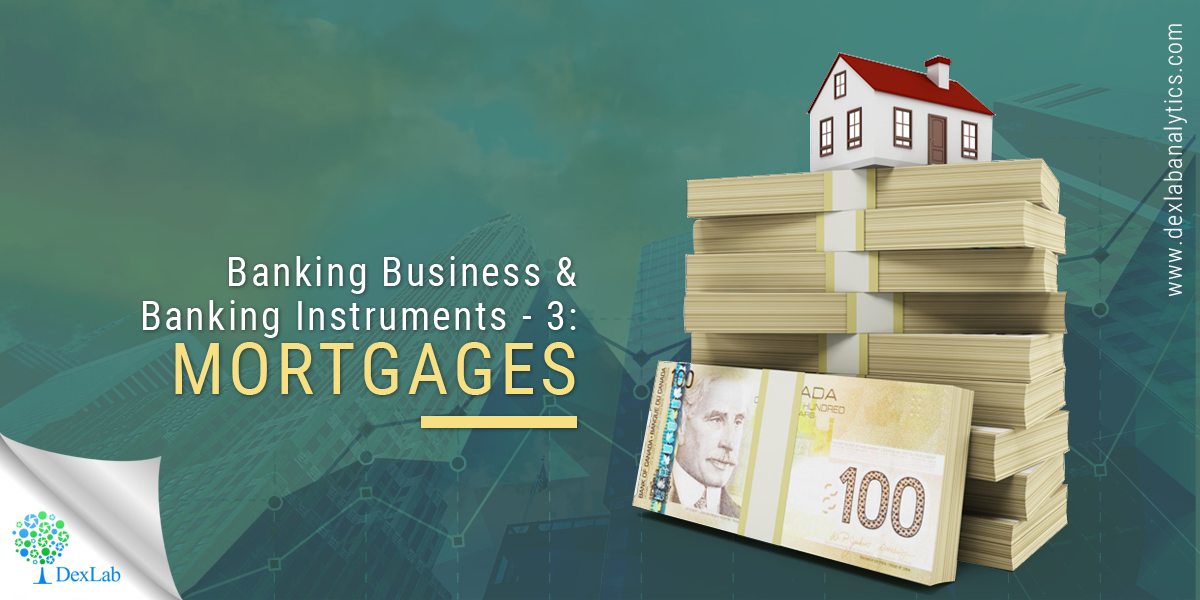In this blog we discuss the final banking instrument- Mortgages, for which models are developed extensively. A mortgage is a debt instrument, secured by the collateral of specified real estate property that the borrower is obliged to pay back with a pre-determined set of payments. Mortgages are used by individuals and businesses to make large real estate purchases without paying the entire value of the purchase upfront.
Mortgages are mainly of two types: (a) Traditional Mortgages (b) Adjusted Rate Mortgages.
Traditional Mortgage is a fixed rate mortgage, where the borrower pays the same a fixed rate of interest for the life of the mortgage. The monthly principal and the interest payments never change from the first payment to the last. Most fixed rate mortgages have a 15-30 year term. If the market interest rate rises, the borrowers’ payment does not change. If the market interest rate drops significantly, the borrower may secure the lower rate by re-financing the mortgage.
Adjusted Rate Mortgage is a mortgage loan in which the interest rate changes based on a fixed schedule after a “fixed period” at the beginning of the loan. This type of loan is riskier because payment can change significantly. In exchange for the risk associated with the ARM, the homeowner is rewarded with an interest rate lower than that of a 30 year old fixed rate. Some types of ARMs are: (a) 10/1 ARM (b) 2-step mortgage (c) Balloon mortgage etc. Here we discuss only the first type:
(a) 10/1 ARMs: These mortgages have an initial interest rate that is fixed for the first ten years of the loan. After the ten years is up, the rate adjusts each year for the remainder of the loan.
(b) 2-step mortgage: In this mortgage scheme, there is a rate of interest for one part of the loan, and another rate of interest for another part of the loan. The rate of interest changes or adjusts in accordance to the rates in the current markets.
Traditional Mortgages v/s ARMs: Traditional mortgages have their own advantage over the ARMs, the biggest advantage being that homeowners know exactly what principal and interest they would need to pay. Traditional mortgages are preferred over the ARMs especially when the interest rates are high, as the former insulates the homeowner against the volatility in the interest rates. Traditional mortgages are more preferred option compared to the ARMs given their non-risky nature.
Analytics for Modelling Mortgage Credit Risk:
The mortgage credit risk models are heavily dependent on the assumption of the distribution of the asset prices .Most standard class of credit risk models for mortgages are (i) PD, LGD and EAD models for modelling expected loss (ii) VaR ( Value-at-risk) for modelling unexpected loss. But the best known example of a model for mortgage default is the one developed by Merton (1976) option pricing model. The option pricing model assumes that housing loans are long term loans given out for purchasing a house and housing prices oscillate over time around the initial purchase value. The implications of this assumption are as follows: Bank “buys” the house on behalf of the borrower and also sells him the option of selling the house in the future and cash out if the equity becomes sufficiently large. The problem arises if the equity becomes small or negative, the borrower may choose to default. The model makes some useful predictions about the occurrence of defaults in mortgage:
– A high loan to value ratio will increase the likelihood of negative equity position occurring in the future and thus raising the expected PD. It will also increase the LGD for borrowers.
– An increase in the house price risk adds both to the expected PD and LGD
– A loan with longer maturity will have a higher PD than a short term loan.
In standard mortgage finance contracts the loan value is amortised, equity is built up as the loan seasons. A prudent under written loan will have a low LTV and hence PD remains low even immediately after the deal has been closed. This probability is the conditional probability given that the account has survived in the previous year.
For encompassing market risk modeling training, look no further than DexLab Analytics. It is a premier online training platform in India that offers superb market risk training courses online. Go check out the courses now.
Interested in a career in Data Analyst?
To learn more about Machine Learning Using Python and Spark – click here.
To learn more about Data Analyst with Advanced excel course – click here.
To learn more about Data Analyst with SAS Course – click here.
To learn more about Data Analyst with R Course – click here.
To learn more about Big Data Course – click here.
analytics courses, Analytics courses in Pune, Banking Business, Credit and Market Risk, Market Risk Analytics, market risk certification, market risk courses, market risk modeling analyst, market risk modeling training, Market Risk Modelling interactive session, Market Risk Training, market risk training courses


